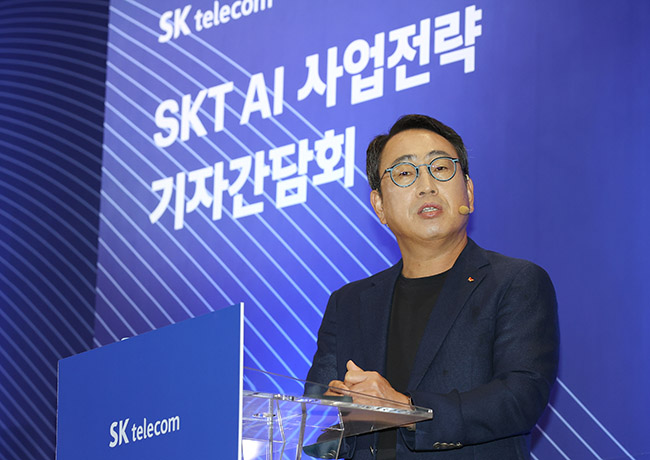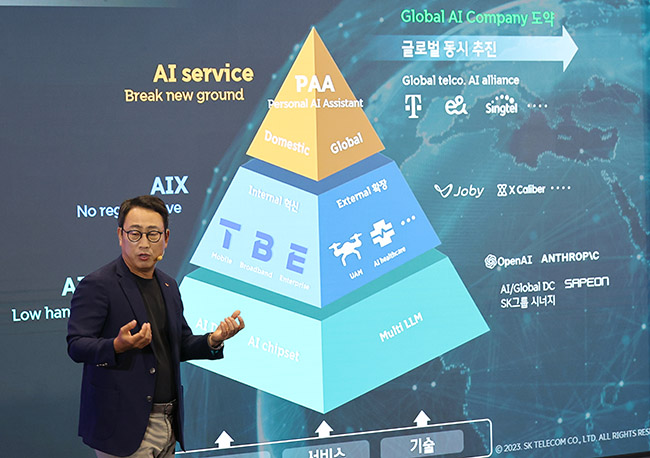
SK Telecom President You Young-sang has likened the AI surge to a “gold rush” and stressed that it presents an unconditional opportunity for telecom companies. (Image courtesy of Yonhap)
SEOUL, Sept. 28 (Korea Bizwire) – SK Telecom held a press conference this week at T Tower’s Supex Hall to announce its goal of becoming a major player in the global AI industry. The company aims to boost its competitiveness in AI and collaborate across various sectors.
While SK Telecom, the leading wireless carrier in the country, is betting big on AI, experts believe that it’s a strategic move considering the changing landscape. The telecom industry faces challenges in generating revenue solely from communication services.
Currently, South Korea’s three major telecom companies are dealing with market saturation, as they are competing for the same pool of subscribers. Additionally, with the population gradually declining, future subscriber growth appears unlikely. The government’s commitment to reducing telecom fees further complicates the outlook for revenue growth in telecom services.
Telecom companies have been actively seeking alternative revenue sources, such as ventures into virtual reality, the metaverse, and the content market. In this context, the global AI trend offers a fresh opportunity for telecom firms, particularly SK Telecom, which has been striving to expand beyond its role as the top wireless operator in South Korea.
SK Telecom President You Young-sang has likened the AI surge to a “gold rush” and stressed that it presents an unconditional opportunity for telecom companies. The company has set specific targets, aiming to increase its AI investment to 33 percent over the next five years, nearly tripling the previous five-year investment of 12 percent, with the goal of achieving over 25 trillion won in revenue by 2028.

SK Telecom unveiled its ‘AI Pyramid Strategy,’ centered around three key areas: ‘AI Infrastructure,’ ‘AIX,’ and ‘AI Service.’ (Image courtesy of Yonhap)
Major global tech companies, including Google, Microsoft, Amazon, Nvidia, Tesla, and others are already engaged in fierce competition in the AI sector. You has observed the emergence of a combination of large language models (LLMs) and cloud computing, along with growing demand for high-performance semiconductors for AI applications.
He also anticipates the formation of a global triad in the LLM space, consisting primarily of Google, Microsoft, and Amazon due to the substantial investments, technology bases, and infrastructure required for sustainable leadership.
Given this backdrop, SK Telecom unveiled its ‘AI Pyramid Strategy,’ centered around three key areas: ‘AI Infrastructure,’ ‘AIX,’ and ‘AI Service.’ In the AI Infrastructure domain, the company plans to enhance its data center, AI semiconductor (Sapion), and multi-LLM ventures. In the AI Service sector, SK Telecom intends to take the lead by officially launching its AI personal assistant, A.Dot.
SK Telecom envisions A.Dot evolving into a personalized AI assistant, revolutionizing customer communication experiences, and expanding the integration of AI services into daily life. Notably, the AI phone distinguishes itself by fostering new connections through innovative communication features unique to a telecommunications company. It will provide various AI services and mobile experiences based on understanding and reasoning from call contexts.
Kevin Lee (kevinlee@koreabizwire.com)






